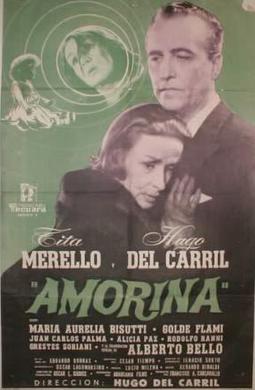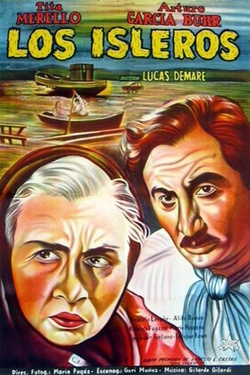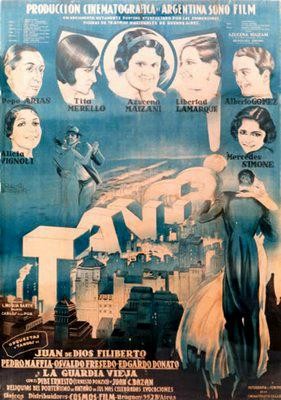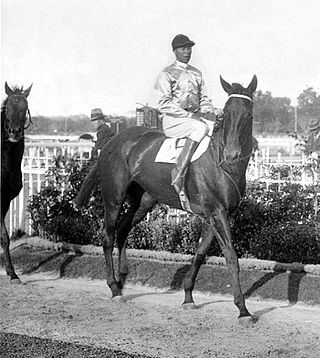
Filomena Marturano is a 1950 Argentine musical film of the classical era of Argentine cinema. It is based on the theatrical piece Filumena Marturano by the Neapolitan actor and author Eduardo De Filippo, which had been previously performed in Argentina with great success by the company of Tita Merello. It was adapted by Ariel Cortazzo and María Cruz Regás. It was directed by Luis Mottura. It starred Tita Merello and Guillermo Battaglia.
Argentina Sono Film S.A.C.I. is an entertainment company based in Buenos Aires that was one of the most important studios during the Golden Age of Argentina cinema of the 1930s–1950s. In its current format, it serves as a production and distribution company.

Amorina is a 1961 Argentine black and white film directed by Hugo del Carril and written by César Tiempo. It is based on a play by Eduardo Borrás. It stars Hugo del Carril and Tita Merello.

Laura Ana "Tita" Merello was an Argentine film actress, tango dancer and singer of the Golden Age of Argentine cinema. In her six decades in Argentine entertainment, at the time of her death, she had filmed over thirty movies, premiered twenty plays, had nine television appearances, completed three radio series and had had countless appearances in print media. She was one of the singers who emerged in the 1920s along with Azucena Maizani, Libertad Lamarque, Ada Falcón, and Rosita Quiroga, who created the female voices of tango. She was primarily remembered for the songs "Se dice de mí" and "La milonga y yo".

Tulio Demicheli was an Argentine born Spanish film director, screenwriter and film producer notable for his work during the classical era of Argentine cinema.

Así es el tango is a 1937 Argentine romantic drama film musical directed and written by Eduardo Morera, based on a play by Florencio Chiarello. Starring Tita Merello and Tito Lusiardo. Based on tango culture, it is a typical product of the Golden Age of Argentine cinema.

Idols of the Radio is a 1934 Argentine musical tango film directed by Eduardo Morera, written by Nicolás de las Llanderas and Arnaldo Malfatti, and starring Ada Falcon, Tito Lusiardo and Tita Merello. It was released during the early years of the Golden Age of Argentine cinema.

Cadetes de San Martín is a 1937 Argentine film directed by Mario Soffici and written by José A. Saldías during the Golden Age of Argentine cinema. It stars Enrique Muiño and Elías Alippi.
Ashes to the Wind is a 1942 Argentine film directed by Luis Saslavsky during the Golden Age of Argentine cinema.

Los isleros is a 1951 Argentine film directed by Lucas Demare, during the classical era of Argentine cinema. It was entered into the 1951 Cannes Film Festival. It won the Silver Condor Award for Best Film.
Deshonra is a 1952 Argentine film of the classical era of Argentine cinema directed by Daniel Tinayre, who was also one of the co-writers. It was the first portrayal of a lesbian love affair.
La Morocha is a 1958 Argentine film, which was actually filmed in 1955. Due to the military coup d'état which ended the presidency of Juan Perón, the film was not released until 1958. The film is in black and white, directed by Ralph Pappier and written by Sixto Pondal Ríos and Carlos Olivari and the premier date was on 30 January 1958. The stars were Tita Merello, Alfredo Alcón, Luis Arata y Rolando Chávez. This was the last film of Luis Arata.

Alita Blanca Barchigia, better known as Alita Román, was an Argentine film actress of the Golden Age of Argentine cinema.
The Bastard is a 1954 film of the classical era of Argentine cinema, directed by Lucas Demare, produced by Argentina Sono Film, and starring Tita Merello. The film won two awards at the eleventh Silver Condor Awards: Best Director and Best Actress, for Merello.

¡Tango! is a 1933 Argentine musical romance film, the first film to be made in Argentina using optical sound technology Many existing stars of the Argentine stage and radio appeared in the film, but its success was limited due to poor sound quality and weak acting. ¡Tango! established a formula that would be used by many subsequent tango films.

La fuga is a 1937 Argentine drama film directed by Luis Saslavsky and starring Santiago Arrieta.
Pampa Film was an Argentine film production company that was active during the Golden Age of Argentine cinema in the 1930s and 1940s. It is known for its classic Prisioneros de la tierra (1939).

Aída Olivier was an Argentine dancer, vedette and actress of cinema and theatre.

Irineo Leguisamo was a Uruguayan jockey. Also known as El Pulpo, El Eximio or El Maestro, he competed for over 57 years at racecourses in Uruguay and Argentina and was considered the foremost South American rider of the 20th century.













